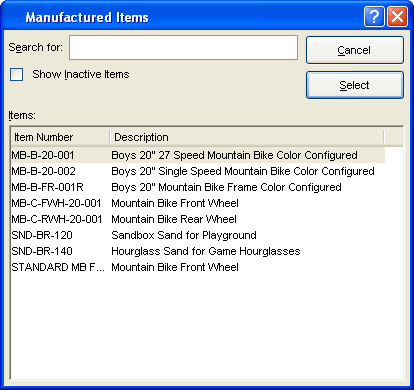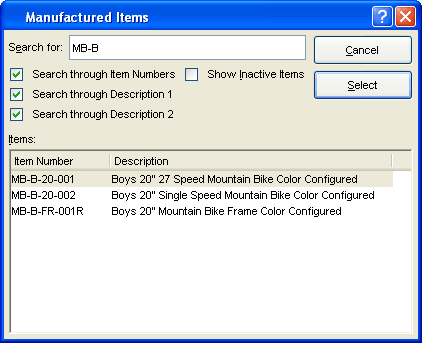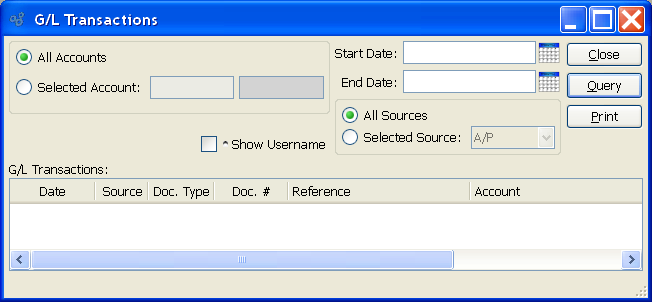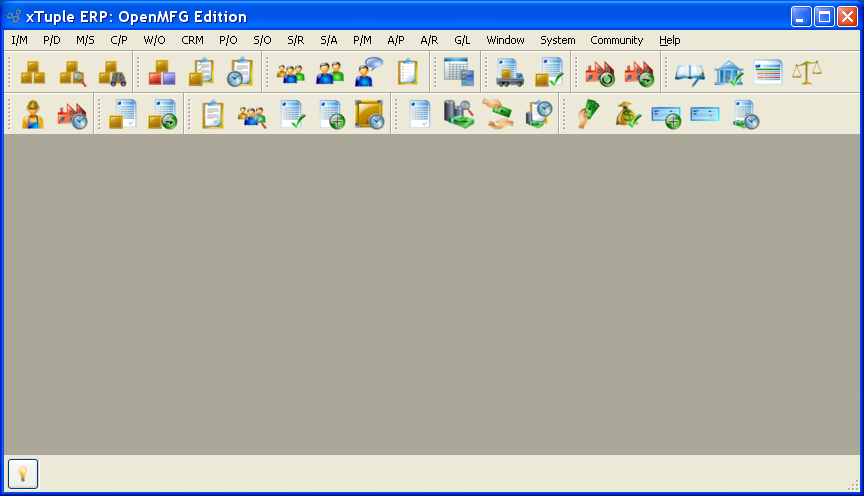Many people prefer to use keyboard shortcuts—instead of a mouse—when navigating within a software application. xTuple ERP features a number of keyboard shortcuts designed just for this purpose.
The TAB key on your keyboard may be used to move the cursor from one field to the next within any given data-entry screen. Simply place the cursor in the first field you want to enter data into—and when you"re done entering data, hit the TAB key to move the cursor to the next field.
Also use the TAB key as a shortcut for converting date field entries to the proper format for your system. For example, in a "Start Date" field you might enter the numbers "022503". Then, with the cursor still blinking in the field, hit the TAB key. The date will be converted to "02/25/03"—or whatever the proper date format is for your system. For more information on keyboard shortcuts related to dates, see the Section 1.2.7.4, “ Date Shortcuts”.
Note
Date formats are controlled by Locale settings.
Three keyboard shortcuts are available at several points throughout the application when you place the cursor in an "Item Number" field. You saw the "Item Number" field in the Bill of Materials example above. The "Item Number" field appears frequently throughout the application. Use the CTRL key—usually located on the bottom left-hand corner of your keyboard—in combination with either "L", "A", or "S" to reach the three screens shown in the following examples:
Tip
Macintosh users should substitute the APPLE key for the CTRL key to achieve the results described in this section.

- List (CTRL + L)
This is the same Item lookup you would reach if you clicked your mouse on the browse button located next to the "Item Number" field.


- Search (CTRL + S)
-
Search for Items using a variety of search criteria. This shortcut enables you to look up Manufactured Items using partial values. In the above example, the user selected all available search options—except for the "Show Inactive Items" option—to search for a match for "MB-B." In this case, the application will search the master list of Items for any Item containing "MB-B" in either the Item Number, the first line of the Item description, and/or the second line of the Item description.
You can also search for matches using any one or a combination of these search options. For example, let's say you are looking for any Manufactured Item containing the word "Bike" in the first line of the Item description. To perform this search, simply enter the word "Bike" in the "Search For" field, then select the "Search through Description 1" option. Leave the other options unchecked. Any Item containing the word "Bike" in the first line of its Item description will display in the results.
You will notice throughout the application that several characters—or individual letters within words—are underlined. In the sample Bill of Materials screen, for example, the SAVE button has the first letter, "S", underlined. The first letter, "C", in the CANCEL button is also underlined. Alternately, notice that the MOVE DOWN button has the "W" underlined. The list could go on.
If you depress the ALT key on your keyboard in combination with any of these underlined letters, the effect is the same as if you had used the mouse to select that button or field. For example, the following combination of keys will activate the PRINT button: ALT + P. The following keyboard shortcut will cancel or close a screen: ALT + C. Or, move a component Item down a notch in a Bill of Materials display with the following shortcut: ALT + W.
xTuple ERP supports a number of keyboard shortcuts for dates. These shortcuts are designed to save you time when entering dates in date fields. Keep in mind, you are required to hit the TAB key after entering a shortcut value in a date field. The TAB key is required to complete all date shortcut entries. The following table describes these date shortcuts in more detail:
Note
xTuple ERP accepts a number of different "input" formats for dates. Any of the following date formats will be accepted by the application:
MM/DD/YY
MM/DD/YYYY
M or MM / D or DD / YY or YYYY
While date input formats may vary, the "output" format (i.e., how dates display on screen) is defined by your Locale settings.
Table 1.1. Date Shortcuts
0+TAB Key |
Entering the number "0" followed by the TAB key in an empty date field will automatically enter today's date in the date field. |
+num |
The "+" symbol followed by a whole number will enter the date occurring num number of days after today's date: Example: Entering "+1" would give you tomorrow's date, "+2" would give you the day-after-tomorrow, etc. |
-num |
The "-" symbol followed by a whole number will enter the date occurring num number of days before today's date: Example: Entering "-1" would give you yesterday's date, "-2" would give you the day-before-yesterday, etc. |
num |
A standalone number will enter the day of the current month represented by that number. Examples: Entering "12" in the month of March, 2003 would give you March 12, 2003. Similarly, the number "23" would give you March 23, 2003, etc. Any number from 1 to 99 may be entered. If the number entered is greater than the last day of the current month, the date will automatically default to the last day of the month. In other words, entering the numbers "99" or "75" or "32" would automatically enter the last day of the current month. |
#num |
The "#" symbol followed by a whole number will enter the day of the current Julian calendar year represented by that number. Examples: Entering "#1" in the year 2003 would give you January 1, 2003. Similarly, "#100" would give you April 10, 2003. Entering "#365" would give you December 31, 2003. |
Tip
Some date fields support time-periods represented by words—such as "Earliest" and "Latest". Keep in mind that these words are case-sensitive. They will not work unless the first letter of the word is capitalized.
In addition to the keyboard shortcuts for dates, you also have the option of selecting the calendar button located to the far right of every date field in the application. The calendar buttons are shown in the following screen shot next to the Start Date and End Date fields:

The calendar functionality is simple to use. All you do is open the calendar, then select the date you want to be entered into the field. To change a date, simply reopen the calendar and select a new date. You can easily navigate between months—and even between years.
Tip
The calendar can be used interchangeably with manually entered dates and date shortcuts. You don't have to use one or the other.
For users who prefer using buttons instead of drop-down menus, the application offers a variety of toolbar button options. The following screen shows the application desktop with all available toolbar buttons turned on:
Note
You can control the display of toolbar buttons on your desktop. Turn them on or off on a module-by-module basis, using the settings available in the User Preferences section of the System module. In addition, you may drag-and-drop toolbar buttons, allowing them to float or attach to alternate locations on the application desktop.

To access the function described by a button, simply select the button using your mouse. Toolbar buttons function in the same way drop-down menu selections do—they simply provide a convenient shortcut. The complete list of available toolbar buttons is shown in the following table:
Table 1.2. Toolbar Buttons Master List
Image |
Function |
Module |
|---|---|---|
 |
List Item Sites |
I/M |
 |
Inventory Availability by Planner Code |
I/M |
 |
Item Availability Workbench |
I/M |
 |
List Items |
P/D |
 |
List BOMs |
P/D |
 |
List BOOs |
P/D |
 |
Run MRP by Planner Code |
M/S |
 |
Planned Orders by Planner Code |
M/S |
 |
Shop Floor Workbench |
W/O |
 |
W/O Schedule by Planner Code |
W/O |
 |
List Unposted P/Os |
P/O |
 |
Purchase Requests by Planner Code |
P/O |
 |
Customer Information Workbench |
S/O |
 |
List Open Sales Orders |
S/O |
 |
Uninvoiced Shipments |
S/O |
 |
Billing Selections |
S/O |
 |
Summarized Backlog by Site |
S/O |
 |
Issue Stock to Shipping |
S/R |
 |
UnPosted Receipts |
S/R |
 |
List Accounts |
CRM |
 |
List Contacts |
CRM |
 |
Incident Workbench |
CRM |
 |
List To-Do"s |
CRM |
 |
List Projects |
P/M |
 |
List Unposted Vouchers |
A/P |
 |
Select Payments |
A/P |
 |
Prepare Check Run |
A/P |
 |
View Check Run |
A/P |
 |
A/P Aging |
A/P |
 |
List Unposted Invoices |
A/R |
 |
A/R Workbench |
A/R |
 |
Cash Receipt Edit List |
A/R |
 |
A/R Aging |
A/R |
 |
List Unposted Journal Entries |
G/L |
 |
Reconcile Bank Account |
G/L |
 |
View Financial Report |
G/L |
 |
View Trial Balances |
G/L |
 |
Event Notification |
System |
 |
Database Error Notification | System |
Tip
If you hover your mouse above a toolbar button, the name of the function associated with the button will appear. Use this technique to quickly learn the identity of the toolbar buttons.